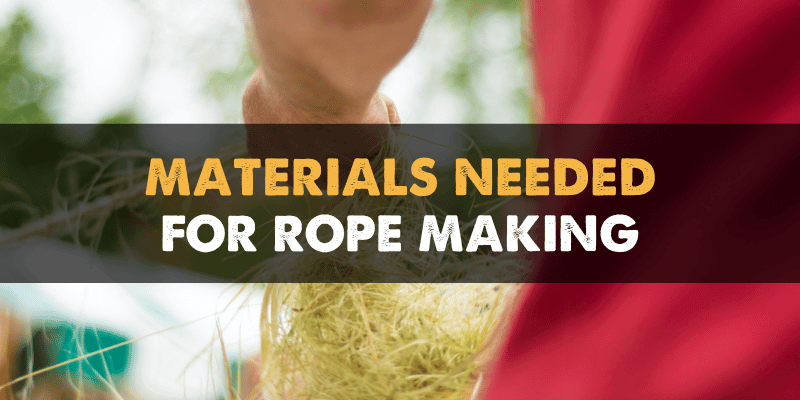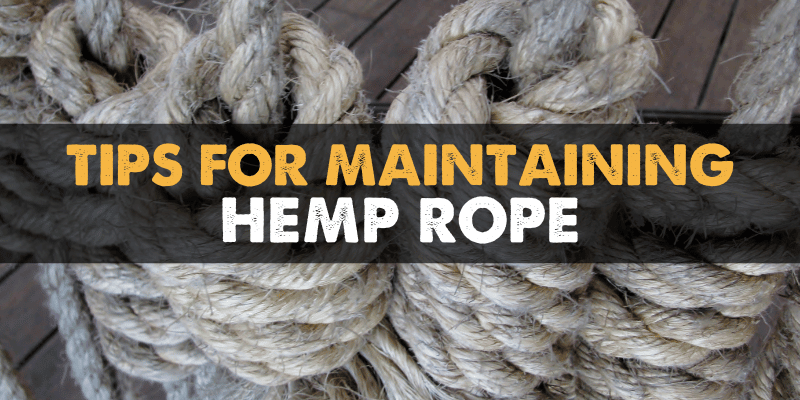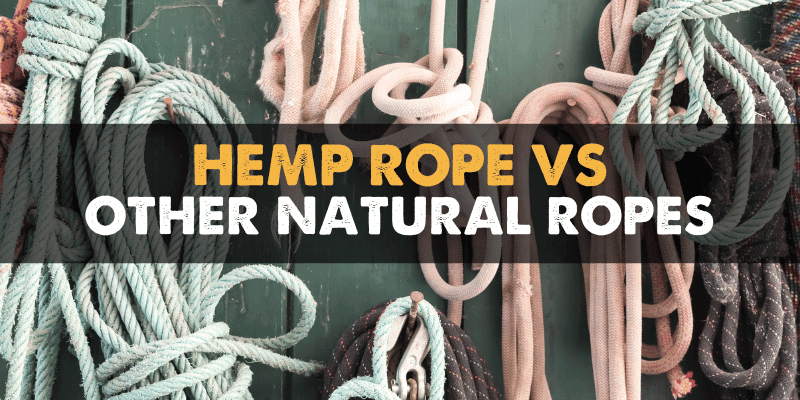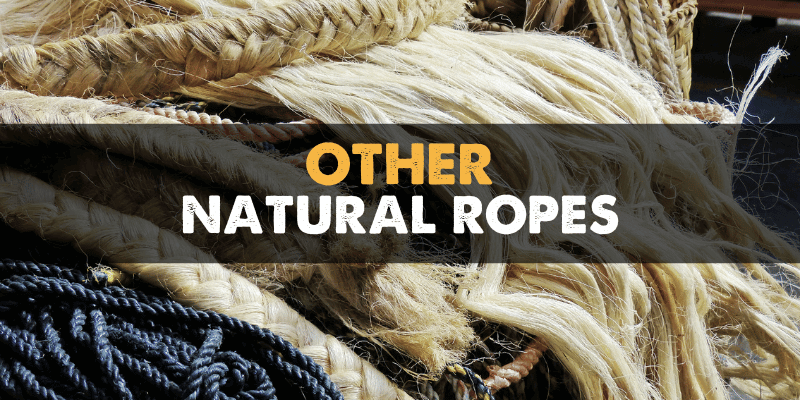

- Author Bulk Hemp Warehouse
- Categories: Hemp Benefits, Hemp Rope, Hemp Uses
How to Make Rope From Hemp
How to make rope from hemp is a simple and sustainable craft that has been used for centuries.
Hemp, a fast-growing plant, produces strong and durable fibers, making it ideal for rope-making.
In this guide, I will provide step-by-step instructions on making rope from hemp fibers, including the materials you’ll need and the techniques involved.
Key Takeaways:
- Hemp rope is a sustainable and durable option for various applications.
- Materials needed include hemp fiber or twine and a wooden dowel.
- Follow a twisting process to create your own hemp rope.
- Hemp rope has practical uses such as clotheslines and pet leashes.
- Maintain hemp rope by preventing fraying and storing it properly.

Why Choose Hemp for Rope Making?
Hemp is an ideal choice for rope making due to its sustainable and durable fibers.
Unlike other natural fibers, hemp grows quickly and abundantly without the need for fertilizers or pesticides, making it an environmentally-friendly option.
The strong and sturdy fibers of hemp rope make it suitable for various applications, both indoors and outdoors.
Compared to cotton or flax fibers, hemp fibers are stronger and more durable, ensuring that the rope can withstand heavy use and weight.
This makes hemp rope a reliable choice for tasks that require strength and durability, such as outdoor activities, camping, and construction.
Its natural resistance to rot and mildew also makes it suitable for humid and wet conditions.
“Hemp rope is not only strong and durable but also environmentally-friendly, making it a sustainable choice for rope making.” – Hemp Crafters Magazine
In addition to its practical benefits, hemp rope also has a natural aesthetic appeal.
The earthy tones and texture of hemp fibers add a rustic and timeless charm to any project or decoration.
Whether you’re making jewelry, crafting home decor, or using it for functional purposes, hemp rope adds a touch of natural beauty.
In a world where sustainability and eco-friendliness have become more than just buzzwords, people are increasingly seeking out natural alternatives to everyday products.
One such alternative that has gained significant traction is hemp – a versatile and incredibly durable material.
In this comprehensive guide, we will take you through the step-by-step process of how to make rope from hemp, from growing the plant all the way to processing it and producing your very own sustainable rope.
Imagine having the ability to create strong, sturdy, and eco-friendly rope right at your fingertips.
Advantages Hemp for Rope Making?
| Advantages of Hemp Rope | Disadvantages of Other Natural Fibers |
|---|---|
| Hemp rope is sustainable and eco-friendly. | Cotton and flax fibers require significant water and chemical usage in cultivation. |
| Hemp fibers are stronger and more durable than cotton and flax fibers. | Cotton fibers are weaker and less durable, especially when exposed to moisture. |
| Hemp rope is resistant to rot and mildew. | Flax fibers are prone to mildew and can rot when exposed to moisture. |
| Hemp rope has a natural aesthetic appeal and adds rustic charm. | Other natural fibers may lack the unique texture and visual appeal of hemp rope. |

The History of Rope Making and Its Significance
Throughout history, rope making has been an essential craft that has played a significant role in human civilization.
The ability to create strong and durable ropes from natural materials provided early settlers with the means to construct shelters, secure food, and navigate treacherous terrains.
Rope making was also crucial for sailors, who relied on ropes for maritime activities such as rigging sails, securing cargo, and even lifesaving maneuvers.
The history of rope making is intertwined with the story of human survival, ingenuity, and self-sufficiency.
Rope held great significance in ancient civilizations, where it symbolized strength, unity, and the bonds that held communities together.
In cultures around the world, rope-making techniques and materials varied, reflecting the availability of local resources and regional craftsmanship.
From twisted plant fibers and animal sinews to more sophisticated techniques using hemp, flax, and silk, rope making evolved and adapted to meet the specific needs of different societies.
“Rope-making is not just about creating a functional tool; it represents self-sufficiency, resourcefulness, and the ability to adapt to different environments.”
Today, while the demand for rope has shifted with advancements in technology and materials, the art of rope making continues to be cherished for its historical significance and practicality.
Learning how to make your own rope not only provides a connection to traditional skills but also fosters a sense of self-sufficiency and independence.
In a world of mass-produced products, there is something deeply satisfying about creating a functional tool with your own hands, using natural materials that have stood the test of time.

Materials Needed for Making Hemp Rope
To make your own hemp rope, you’ll need a few simple materials.
Here’s a list of what you’ll need:
- Hemp fiber or hemp twine
- Wooden dowel
You can purchase hemp fiber or hemp twine online or at craft stores.
These are the main components for creating your hemp rope.
The hemp fiber or twine will form the strands of the rope, while the wooden dowel will be used to secure the fibers during the twisting process.
Having these basic materials on hand will allow you to start making your own hemp rope and explore the craft of rope making.
Materials Needed for Making Hemp Rope
| Materials | Description |
|---|---|
| Hemp fiber or hemp twine | Main component for creating the rope |
| Wooden dowel | Used to secure the fibers during the twisting process |

Step-by-Step Guide to Making Hemp Rope
Creating your own hemp rope is a simple and satisfying process that requires just a few steps.
Follow this step-by-step guide to craft your own eco-friendly rope from hemp fibers:
Step 1: Prepare the Materials:
Gather your materials: hemp fiber or hemp twine, a wooden dowel, and a pair of scissors.
Make sure your hemp fiber or twine is at least twice the length of the desired rope.
Step 2: Fold and Secure:
Fold the bundle of fibers in half to create a loop and place the wooden dowel through the folded loop to secure it in place.
Step 3: Twist the Fibers:
Divide the bundle into two equal parts and twist each bundle clockwise until they start to kink and loop. Keep the tension even while twisting.
Step 4: Twist the Cords Together:
Now, twist the two cords together in a counterclockwise motion, overlapping them and applying consistent tension. This twisting motion will create the rope pattern.
Step 5: Secure the Ends:
When you reach the desired rope length, secure the ends of the rope with overhand knots to prevent unraveling.
Step 6: Repeat for Thicker Rope:
If you want a thicker and stronger rope, repeat the process by twisting multiple smaller ropes together to create a thicker strand.
With these simple steps, you can create your own hemp rope using sustainable materials.
Enjoy the process of twisting and turning the fibers to form a functional and eco-friendly rope.
The Twisting Process
The twisting process is a crucial step in making hemp rope.
By twisting the individual fibers together and then twisting the two cords in the opposite direction, you create a strong and durable rope.
This twisting motion intertwines the fibers, creating friction that holds the rope together, allowing it to withstand heavy use and resist unraveling.
“The twisting process is a delicate balance of tension and motion, requiring patience and practice to master.” – Hemp Rope Craftsmanship

Common uses for hemp rope?
Hemp rope has a wide range of practical and decorative uses.
Its strength and durability make it suitable for various applications, both indoors and outdoors.
Jewelry Making
Hemp rope is a popular choice for creating unique and eco-friendly jewelry pieces.
Its natural color and texture add a rustic charm to necklaces, bracelets, and even hair wrap pieces.
Hemp rope is popular for creating unique and eco-friendly jewelry pieces due to its rustic charm and natural color that complements necklaces, bracelets, and earrings.
Most hemp jewelry is actually made of hemp twine, but hemp rope if thin enough can be used.
Hemp rope adds an earthy and unique aesthetic to jewelry making.
Adding beads or charms enhances their appeal and personalizes them to your style.
Whether you’re a jewelry maker or someone who appreciates natural fibers, hemp rope offers endless possibilities for creating unique and eco-friendly jewelry.
Its rustic charm and versatility allow you to unleash your creativity and add a touch of nature-inspired elegance to your accessories.
So, explore the possibilities of hemp rope and reflect your unique style with handmade jewelry.
Clothesline
Using hemp rope as a clothesline is not only practical but also environmentally friendly.
It allows you to air-dry your laundry, reducing energy consumption and extending the life of your garments.
Pet Leashes
Hemp rope’s strength and durability make it an ideal material for pet leashes.
It can withstand the pulling and tugging of energetic pets, providing a reliable and sturdy option for walks and outdoor activities.
Decorative Uses
Hemp rope can be used decoratively in various ways, such as wrapping it around vases or jars to create a rustic look, hanging it as a curtain tieback, or incorporating it into macramé wall hangings.
Hemp rope is not only functional but also adds a touch of natural beauty to any space. Its decorative uses are endless, and it can instantly transform the ambiance of a room.
One popular way to incorporate hemp rope decoratively is by wrapping it around vases or jars.
This simple yet effective technique creates a rustic and earthy look, perfect for adding a natural element to your home decor.
Use hemp rope as a unique and eco-friendly curtain tieback for a relaxed and inviting atmosphere with a touch of bohemian charm.
Add a touch of handmade artistry to your walls with hemp rope macramé wall hangings. These intricate designs create a beautiful and organic focal point in any room.
Hemp rope can be used creatively in various ways, such as wrapping handles or weaving baskets for a rustic touch.
It can also be used to create DIY plant hangers, adding style and charm to indoor plants. The natural fibers beautifully complement the greenery, creating a calming effect.
Hemp rope is a versatile and eco-friendly material that adds rustic charm to your home decor. Explore the endless possibilities of hemp rope in your decorative endeavors.
Hemp Rope Macramé
Hemp rope is a versatile material for macramé, creating durable and rustic pieces.
Discover exciting macramé projects using hemp rope.
One popular macramé project using hemp rope is a plant hanger.
By knotting the rope in various patterns, you can create a sturdy and stylish hanger that will beautifully showcase your favorite plants.
The natural color of the hemp rope adds an earthy touch, making it a perfect complement to your indoor or outdoor greenery.
Hemp rope is also great for creating captivating and unique wall hangings.
The texture and thickness of the rope add depth and dimension to these visually striking artworks, making them a stunning focal point in any room.
Make a durable and stylish market tote using hemp rope. With a few knots and braids, create a fashionable and eco-friendly accessory perfect for shopping or beach trips.
Hemp rope can also be used to make intricate and decorative jewelry pieces through macramé techniques.
From bracelets and necklaces to earrings and anklets, the possibilities are endless.
The natural look and feel of hemp rope lend a bohemian and organic vibe to your jewelry creations, making them a unique addition to your accessory collection.
Hemp rope is a versatile and sustainable material for macramé projects.
Whether you’re a beginner or an experienced artist, the natural fibers of hemp rope allow you to create beautiful and functional pieces.
So grab your hemp rope and get creative – the possibilities are endless!
Hemp Rope for Shibari
Shibari is a form of Japanese rope bondage. The word Shibari comes from the Japanese word meaning “to tie” or “to bind”.
Shibari is not only an art form, but it is also a form of communication and intimacy.
It can be used as a form of foreplay, as a way to create a deeper connection with your partner, or simply as a way to relax and feel more connected to your body.
There are many different ways to tie someone up using Shibari.
The most important thing is to be creative and to have fun!
Here are some tips to get you started:
1. Choose the right rope. Hemp fiber rope is the best choice for Shibari because it is strong and durable. You will also need a rope that is at least 6 meters (20 feet) long.
2. Make sure the rope is not too tight. The goal of Shibari is to create a sensation of being restrained, not to cause pain.
3. Start with simple knots. The basic Shibari knots are the reef knot and the square knot. These knots can be used to create a variety of patterns and shapes.
4. Be creative! Use your imagination to create different patterns and shapes. You can even use clothes to tie someone up.
5. Take your time. Shibari is not about hurry, it’s about taking the time to enjoy the process and create a deeper connection with your partner.
As you can see, hemp rope has a wide range of practical and decorative uses.
Whether you’re looking to create unique jewelry pieces, air-dry your laundry, or make durable pet leashes, hemp rope is a versatile and eco-friendly choice.
Its strength and durability make it a reliable option for various applications, while its natural look adds a touch of rustic charm to any project.

Tips for Maintaining Hemp Rope
Maintaining hemp rope is essential to ensure its longevity and performance.
By following these simple tips, you can prevent fraying, keep your rope clean, and protect it from damage.
Preventing Fraying
To prevent fraying, it is important to take proactive measures.
One effective method is to use masking tape to wrap the ends of the rope.
his will create a barrier that prevents the fibers from unraveling.
Another option is to apply a thin coat of clear nail polish to the ends of the rope.
The nail polish acts as a sealant, keeping the fibers secure and protected.
Cleaning Hemp Rope
Cleaning hemp rope is a straightforward process.
Start by hand washing the rope with a mild soap and warm water.
Gently scrub the rope to remove any dirt or debris.
Avoid using harsh chemicals or bleach, as they can weaken the fibers.
After washing, rinse the rope thoroughly and allow it to air dry. This will help maintain the integrity of the hemp fibers.
Treating Hemp Rope
Treating hemp rope with a natural oil, such as mineral oil, can help condition and protect the fibers.
Apply a small amount of oil to a clean cloth and rub it onto the rope, ensuring even coverage.
The oil not only moisturizes the fibers but also provides a protective layer against moisture and UV damage.
However, be cautious not to over-treat the rope, as excessive oil can attract dirt and cause the rope to become sticky.
Proper Hemp Rope Storage
Proper storage is crucial to maintaining the quality of hemp rope.
Store the rope in a cool, dry place away from direct sunlight.
Sunlight exposure can cause the rope to fade and deteriorate over time.
Additionally, make sure the rope is stored in a way that minimizes tangling, as knots and tangles can weaken the fibers.
By following these storage guidelines, you can keep your hemp rope in optimal condition for years to come.
Summary of Tips for Maintaining Hemp Rope |
|---|
| Prevent fraying by using masking tape or clear nail polish on the ends of the rope. |
| Clean hemp rope by hand washing it with mild soap and warm water. Avoid harsh chemicals or bleach. |
| Treat hemp rope with a natural oil, such as mineral oil, to condition and protect the fibers. |
| Store hemp rope in a cool, dry place away from direct sunlight to prevent fading and deterioration. |
By following these tips, you can maintain the quality of your hemp rope and ensure its durability and longevity.
Whether you use hemp rope for practical purposes or as a decorative element, proper maintenance will help you get the most out of your rope and enjoy its benefits for years to come.

Comparison between Hemp Rope and Other Natural Fibers
When it comes to rope making, there are various natural fibers to choose from, each with its own set of characteristics and strengths.
Hemp rope, cotton rope, flax rope, silk rope, and jute rope are some of the most common options available.
Let’s take a closer look at the comparison between hemp rope and these other natural fibers.
Hemp Rope
Hemp rope is known for its exceptional strength and durability.
It is made from the fibers of the hemp plant, which are naturally strong and resistant to wear and tear.
Hemp rope is often used in outdoor and nautical settings due to its ability to withstand moisture and resist rotting.
It is also a sustainable choice as hemp plants grow quickly and require minimal pesticides or fertilizers.
Cotton Rope
Cotton rope is another popular natural fiber option.
It is softer and more lightweight compared to hemp rope, making it a good choice for applications where flexibility and comfort are important.
However, cotton rope is not as strong or durable as hemp rope, and it may deteriorate over time when exposed to moisture or heavy use.
Flax Rope
Flax rope is made from the fibers of the flax plant and is known for its strength and durability.
It is similar to hemp rope in terms of its natural resistance to rot and mildew.
However, flax rope tends to be more expensive than hemp rope and may not be as readily available.
Silk Rope
Silk rope is a luxury option that offers a smooth and soft texture.
It is often used for decorative purposes or in specialized applications such as acrobatics.
Silk rope, however, is not as strong as hemp rope and may not be suitable for heavy-duty tasks.
Jute Rope
Jute rope is an affordable natural fiber option that is commonly used for decorative purposes or in light-duty applications. It is biodegradable and eco-friendly, but it is not as strong or durable as hemp rope.
Jute rope may break or fray more easily with heavy use or exposure to moisture.
| Fiber Type | Strength | Durability | Suitability for Outdoor Use | Cost |
|---|---|---|---|---|
| Hemp Rope | High | High | Excellent | Mid to High |
| Cotton Rope | Medium | Medium | Good | Low to Mid |
| Flax Rope | High | High | Excellent | Mid to High |
| Silk Rope | Low to Medium | Medium | Good | High |
| Jute Rope | Low to Medium | Low to Medium | Fair | Low |
Ultimately, the choice between hemp rope and other natural fibers depends on the specific needs of your project.
Consider factors such as strength, durability, suitability for outdoor use, and cost when making your decision.
Whether you’re crafting a sturdy clothesline or creating decorative jewelry, choosing the right natural fiber rope can make a significant difference in the longevity and performance of your creation.

Other Ways to Make Rope from Natural Materials
While hemp is a versatile and sustainable material for rope making, there are other natural materials that can also be used to create ropes.
These alternatives offer unique textures and characteristics that can be suited to different projects.
Let’s explore some other ways to make rope from natural materials.
1. Grass Rope: Grasses such as straw or even long blades of grass can be twisted together to create a rope-like structure. This type of rope can be used for lightweight projects and decorations, but may not have the same durability as hemp rope.
2. Silk Rope: Silk fibers can be twisted or braided together to create a delicate and luxurious rope. Silk ropes are often used in decorative applications such as jewelry making or as accessories for high-end products.
3. Jute Rope: Jute is another plant fiber that can be transformed into rope. Jute ropes have a natural golden color and are commonly used in gardening and household applications. They are less durable than hemp ropes but are more affordable.
4. Yarn Rope: Yarn can be twisted together to create soft and flexible ropes. Yarn ropes are commonly used in knitting and crochet projects, providing a wide range of colors and textures to choose from.
When using these alternative materials, it is important to consider their specific characteristics and limitations.
Experimenting with different fibers can add variety and creativity to your rope-making projects.
Rope Making and Self-Sufficiency
Rope-making is not just about creating a functional tool; it represents self-sufficiency, resourcefulness, and the ability to adapt to different environments.
By learning how to make our own rope, we gain a sense of empowerment and a deeper understanding of the materials we use.
It allows us to tap into our creativity and explore the possibilities that come with being self-reliant.
In an era of mass production and disposable goods, engaging in the ancient craft of rope making allows us to slow down and appreciate the value of handmade items.
It encourages us to be mindful of the resources we consume and to embrace a more sustainable way of living.
By making our own rope, we become active participants in shaping our own lives and reducing our reliance on commercial products.
Ultimately, the history of rope making highlights our innate human capacity for innovation and adaptation.
It reminds us of our connection to the natural world and the importance of preserving traditional skills for future generations.
So, why not embark on your own journey into the art of rope making and discover the significance it holds for you?

Hemp Rope Frequently Asked Questions
Yes, hemp rope is stronger and more durable than cotton, flax, and jute ropes. It has a similar strength to silk rope.
Hemp rope has a wide range of applications, including use as a clothesline, pet leash or collar, and for jewelry making. It is also popular in nautical and outdoor settings.
To maintain hemp rope, you can prevent fraying by using masking tape or clear nail polish on the ends. It can be cleaned by hand washing with mild soap and warm water, and treating it with natural oil can help protect it from moisture and UV damage.
Hemp rope is stronger than cotton and flax ropes, similar in strength to silk rope, and more durable than jute rope. Each natural fiber has its advantages and considerations depending on the specific application.
Other natural materials that can be used to make rope include grass, flax, straw, bark, silk, jute, and even yarn.
Rope making has played a crucial role in human civilization, from early settlers relying on it for survival to sailors using it for maritime activities. It is appreciated for its practicality and self-sufficiency.
Making hemp rope sandals is a fun and easy way to add a unique and stylish touch to your summer wardrobe!
With just a few simple supplies and a little bit of time, you can create your very own pair of beautiful hemp rope sandals.
Here’s what you’ll need to get started:
– A length of hemp rope (available at most craft stores)
– A sharp knife or scissors
– A ruler or measuring tape
– A pencil
– A lighter
First, you’ll need to measure the length of your foot from heel to toe. Add a few inches to this measurement to allow for the width of the sandal straps. Cut a length of hemp rope to this measurement.
Next, you’ll need to mark and cut two pieces of rope for the straps of the sandal. The straps should be about 1-2 inches wide, and long enough to fit comfortably around your foot.
Once you have all of your pieces cut, it’s time to start assembling the sandal! Take one of the long pieces of rope and thread it through the two strap pieces, as shown in the diagram below.
Next, tie a knot in the end of the rope to secure the straps in place. Repeat this step with the other long piece of rope.
Now you should have two long pieces of rope, each with a strap tied in the middle. These are the “laces” for your sandals.
To finish the sandals, simply tie the laces around your ankle and enjoy!
OTHER EDUCATIONAL HEMP POSTS
Explore Other Posts by Bulk Hemp Warehouse

Why Hemp Seeds Are the Ultimate Superfood for Birds – And Why Corn, Wheat, and Soy Don’t Belong in Their Diet
Could hemp seeds be the NEW Bird Feed that beats corn wheat and soy? I think so.

How China Grows and Processes Hemp Fiber – From an American Farmer
Steve Groff, a third-generation farmer from Southeastern Pennsylvania, recently embarked on a transformative journey to China, a trip that has profoundly impacted his perspective on the future of hemp farming and textile production. This wasn’t a casual tourist visit; it

10 Ways to Use Hemp for the Holidays
The holiday season is a time for creativity, warmth, and celebration. Hemp, with its versatility and sustainable nature, offers endless opportunities to make your holiday festivities more eco-friendly and unique. Whether you’re looking for gift ideas, decorations, or a way











